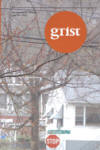Grist – 2013
What sets Grist: The Journal for Writers apart is its “commitment to the writer’s occupation.” To begin with, three interviews with working writers provide appealing insight. Then there are two craft essays, one on metaphor in poetry, one on time in fiction. Mostly, there are 148 pages of poetry, fiction, and creative nonfiction (no book reviews or criticism) of exciting quality. And don’t miss the online companion, a smart nod to the online presence all writers, these days, must have.
What sets Grist: The Journal for Writers apart is its “commitment to the writer’s occupation.” To begin with, three interviews with working writers provide appealing insight. Then there are two craft essays, one on metaphor in poetry, one on time in fiction. Mostly, there are 148 pages of poetry, fiction, and creative nonfiction (no book reviews or criticism) of exciting quality. And don’t miss the online companion, a smart nod to the online presence all writers, these days, must have.
The print journal is an attractively bound 6 x 9 book, easy to hold in the hand and to read on the treadmill (which is important to me), with ample margins on most pages that offset the effect of the dismayingly small text font. (One of the reasons for the online companion is the opportunity for a larger format.) Never mind; it’s still readable. Oh, better than readable. The interview with poet Adam Zagajewski, for example, contains advice every poet needs to hear:
. . . try to always consider the flip side, to have second thoughts, to revise not only our words but also our ideas. And in your reading, in your general orientation, try to go beyond poetry. [Wislawa Szymborska gave me this advice:] read books on history, on biology, geography . . . a year and a half ago, she still complained that critics don’t read anything besides narrowly defined literature.
In Julie Orringer’s interview she describes the writerly concerns and processes that have occupied her during the production of her novels (syntax that’s true to both character and time period; research; humor). And the short interview with Linda Gregerson reminds us that “tradition” is often less on a writer’s mind than staying “true to a rhythm of thought, an image, a question, a fragment of idiomatic speech.”
Nicky Beer’s short essay on metaphor in poetry practices what it argues: “To encounter metaphor in prose is much like riding in a car at night and passing a dilapidated motel’s midcentury neon sign, vivid with age-spotted, vamp-red parabolas . . . in poetry, however, . . . metaphor is the dead cardinal under the chokeberry bush, the cicada husk perched on barbed wire . . .”
Maud Casey’s astute essay on time in fiction analyzes intersecting chronological systems in three novels, including Mrs. Dalloway, which Paul Otremba’s poem “Clarissa in Uptown” echoes marvelously: “Like a great big clock, you wouldn’t look for it / if you didn’t already know it was there . . .” For the writer, all these observations are manna. Thanks to Grist for providing them!
Equally nourishing, though, of course, are the examples of “innovative literature” which the journal “endeavors to articulate and frame.” In poetry, John Cullen’s “Small Town Romance, 1968” perfectly captures the time:
The television replayed assassinations
. . . . . . . . . . . . . . . . . . . . . .
Turn it up!
We yelled, excited.
Turn it down! My father bellowed,
downstairs. We wanted Janis
Joplin’s heat in our faces as she nursed
a Southern Comfort. Her voice
caressed us deep
into her mouth, and the revolution
crashed fences, except
the ones in our town.
It also captures the feeling: “My tongue / nudged her lips and slipped / inside and both of us / fumbled with an unknown/ language . . .”
Amorak Huey’s “Origami Figures in Winter” delicately juxtaposes the idea of haiku with the image of origami in a poem whose every line matters, so that it’s difficult to quote representative perfection. Christina Cook’s “Summer Requiem” also works by finely spun connections—this time the pervasiveness of death with that rich condition of full fruitful summer.
The fiction is similarly stimulating. Vanessa Blakeslee’s “Perfect Conditions,” though it’s ostensibly about surfing, and making films, and negotiating parent-child relationships, is a directive about the perils of navigating any artistic endeavor, including writing. So, too, is Jennifer Stern’s wrenching “The Art of Movement,” whose excellently-evoked first-person protagonist, a married woman with MS, chooses not to have a baby in honor of her own needs.
My favorite of the creative nonfiction is Dana Staves’s online-companion contribution, “This Closet Smells Like Chicken.” Staves explores complexities of “sin.” Product of a Bible-belt childhood, she is now out as a gay person who loves Chick-Fil-A. The first “outing” is frowned upon by fundamentalist religious communities, the second by gay people. Sin is complex; this essay is simply a pleasure to read.
Grist’s website calls it a “resource,” an apt synonym for “grist,” grain to be ground into meal for working and baking. This well-edited, finely-tuned collection of writing by and about good writing, intentionally sown and gleaned by graduate students in the Creative Writing Program at the University of Tennessee, deserves your attention as genuine grist for the serious writer’s mill.
[www.gristjournal.com]





